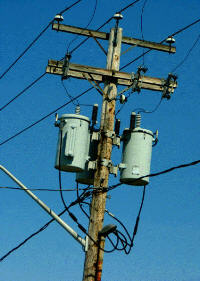 Although PCB use has been largely banned in the United States since 1977, this persistent organic pollutant is still present in our environment. A recent report by the National Scientific Council on the Developing Child, a multidisciplinary organization created in response to the landmark report From Neurons to Neighborhoods : The Science of Early Childhood Development, found that prenatal exposure to PCBs disrupts ” brain plasticity during sensitive periods of development.” Particularly, children’s abilities to recognize sounds at different frequencies is impaired.
Although PCB use has been largely banned in the United States since 1977, this persistent organic pollutant is still present in our environment. A recent report by the National Scientific Council on the Developing Child, a multidisciplinary organization created in response to the landmark report From Neurons to Neighborhoods : The Science of Early Childhood Development, found that prenatal exposure to PCBs disrupts ” brain plasticity during sensitive periods of development.” Particularly, children’s abilities to recognize sounds at different frequencies is impaired.
700,000 tons of PCBs were manufactured by Monsanto, makers of Roundup and genetically-engineered “frankenfoods“, between 1929-1977. Despite the fact that PCBs have not been made for thirty years in the US, environmental exposure is common because PCBs resist degradation. According to “The PCB in Me: Environmental PCB’s and Human Health Risks“,
Individuals may suffer exposure through the use of old fluorescent lighting fixtures, electrical devices, and appliances that were made at least 30 years ago. Food borne exposure is common when eating fish, especially sport fish caught in contaminated lakes or rivers, as well as some meats and dairy products.2 Other sources of exposure include hazardous waste sites, contaminated well water, and workplace exposure during repair and maintenance of PCB transformers, fluorescent lights, and other old electrical devices.2 An example of a common source of non-occupational exposure is a leaking power transformer on an electrical pole on a residential street.
PCBs are still allowed in “closed” systems in the United States, such as capacitors and transformers, making my off-the-grid hydro system not so eco-friendly. Closed use of PCBs has been banned in the UK since 1981. The largest contaminated sites in the US include the Hudson River and the Great Lakes; however, PCBs have been detected throughout the world, even the Arctic Circle.
The harmful effects of PCBs on humans has been known for a long time, and accumulation has been found in human tissues, such as the placenta and uterus, as well as breastmilk. The most common way infants are exposed to PCBs is in breastmilk, although the benefits of breastfeeding outweigh the risks. PCBs are even present in infant foods, and the FDA has set limits of “no more than 0.2-3 parts of PCBs per million parts (0.2-3 ppm) of food.”
The recent report by the National Scientific Council on the Developing Child examined in utero exposure to PCBs. Although the report did not find gross changes in the developing brain resulted from PCB exposure, the ability of developing auditory circuits is impaired. The study explains,
We begin to hear sounds even in the womb, and the infant auditory system continues to require normal hearing experiences to form a precise architecture of nerve connections. The connections are imprecise early in development, but become more finely tuned with hearing experience. The ability to distinguish sounds at different frequencies, and to identify subtle differences in sounds that are essential for learning language and for developing reading skills, resides in the architecture of connections in the auditory region of the cerebral cortex, where the final processing of complex sound information occurs.
In utero exposure to PCBs affects this ability to distinguish between different auditory frequencies. The study was conducted by feeding pregnant and nursing rats PCB coated corn flakes. The results were,
…that the ability to recognize sounds of different frequencies—an essential skill for making both gross and subtle distinctions between kinds of sounds (like ‘pa’ and ‘ca’)—is impaired. Moreover, they demonstrate that the ability of the developing auditory circuits to change is impaired, consistent with the idea that brain plasticity during sensitive periods of developmentis disrupted. The authors note that this is the key mechanism that the brainuses for learning new skills in all animal species and humans. Thus, the lack of gross changes in brain architecture should not be interpreted to mean that all is normal.
We may not be able to avoid PCB exposure from past production, but we can follow the UK’s lead and ban PCBs in closed systems. When will we realize that we can’t just keep creating and using environmental pollutants without consequence? Personally, I have to wonder: Could PCBs be the cause of my son’s expressive language delay?
Image source: American Chronicle.
Hi Blogmaster These days you never know what you are going to find when you click through from the search engines. I searched for brain food – But this is a good blog, and its full of interesting and relevant content. I particularly liked your post l Exposure to PCBs Damages the Brain : Eco Child’s Play.